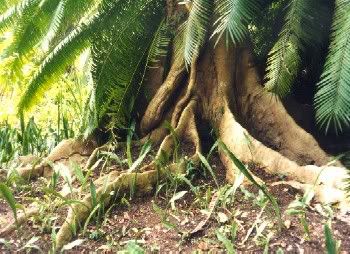

Banyan (Ficus bengalensis)
Folk Names: Arched Fig, Banian, Barh, Indian Fig Tree, Indian God Tree, The Many-Footed Banyan, Strangler Fig, Vada Tree, Zeyton Maskhout
Description: The Banyan is a tropical evergreen of the fig family. The banyan is native to India, growing to a height of one hundred or so feet. It begins its life as an epiphyte. Seeds dropped by birds sprout and take up residence in other trees. Gathering nourishment and water from the air, eventually the lateral branches send roots down to the ground. These support, then enlarge into trunks, and develop new branches. In time, the banyan kills the host tree by strangling it.
Young specimens can be kept in a green house, but they will remain bushy and never fruit. Like most members of the fig family, aerial roots grow down from the spreading branches. These will first absorb moisture from the air until they reach the ground to become new roots and supportive trunks still attached to main plant. A mature banyan canopy may cover an area more than 1,000 feet in diameter. The stems below the canopy form a kind of columned room. Its original trunk may decay, leaving the younger ones to support the tree. The eight-inch long, leathery leaves are ovate and dark green with light green veins. The leaf stalks and young branches are downy. The banyan produces red, round fruits.
Effects: strong
Planet: Jupiter
Element: air
Associated Deities: Maui
Traditions:
The banyan is revered by Hindus and planted near temples. It is connected with worship of the demi-god trickster Maui in Hawaiian and Polynesian religions.
Three thousand years before Pliny described it to the Roman Empire this mighty shade tree struck awe in the Aryan nomads sweeping across Asia. Called "The Many-Footed" after the aerial roots pouring from its trunk to form a small forest, the canopy of a single banyan tree has been known to extend two thousand feet. The Aryan priests linked the banyan's vitality to a flow of light or to a liquid immortality overflowing onto the earth from the goblets of the gods themselves. Their chiefs drank ritually of its sap, believing it could increase their virility and ensure their hold upon conquered lands.
Magic:
It is said to sit under or even look at tree brings luck. Marriages performed under the tree bring happiness. The Banyan trees in ancient Arabia served as places for holding council and negotiating treaties. This same tree is revered as a tree of justice among many cultures.
Known Combinations:
none noted
Medical Indications: Parts Used: Latex, bark, fruits, leaves, roots and root bark, buds, bark, aerial roots.
The tannins and flavonoids relieve capillary bleeding. The latex has antibacterial effects, excellent for minor cuts and skin diseases like scabies, and the bark is tonic, astringent, and cooling. Young buds and milky juice are also astringent.
Nutrition:
The fruit is considered a famine food, not good to eat unless you have nothing else.
Mercantile Uses:
Its sap is a white and sticky latex. This is used to prepare birdlime, which hunters use in capturing birds. The porous wood also makes excellent tooth brushes. In the past, the straight roots were used to make tent poles.